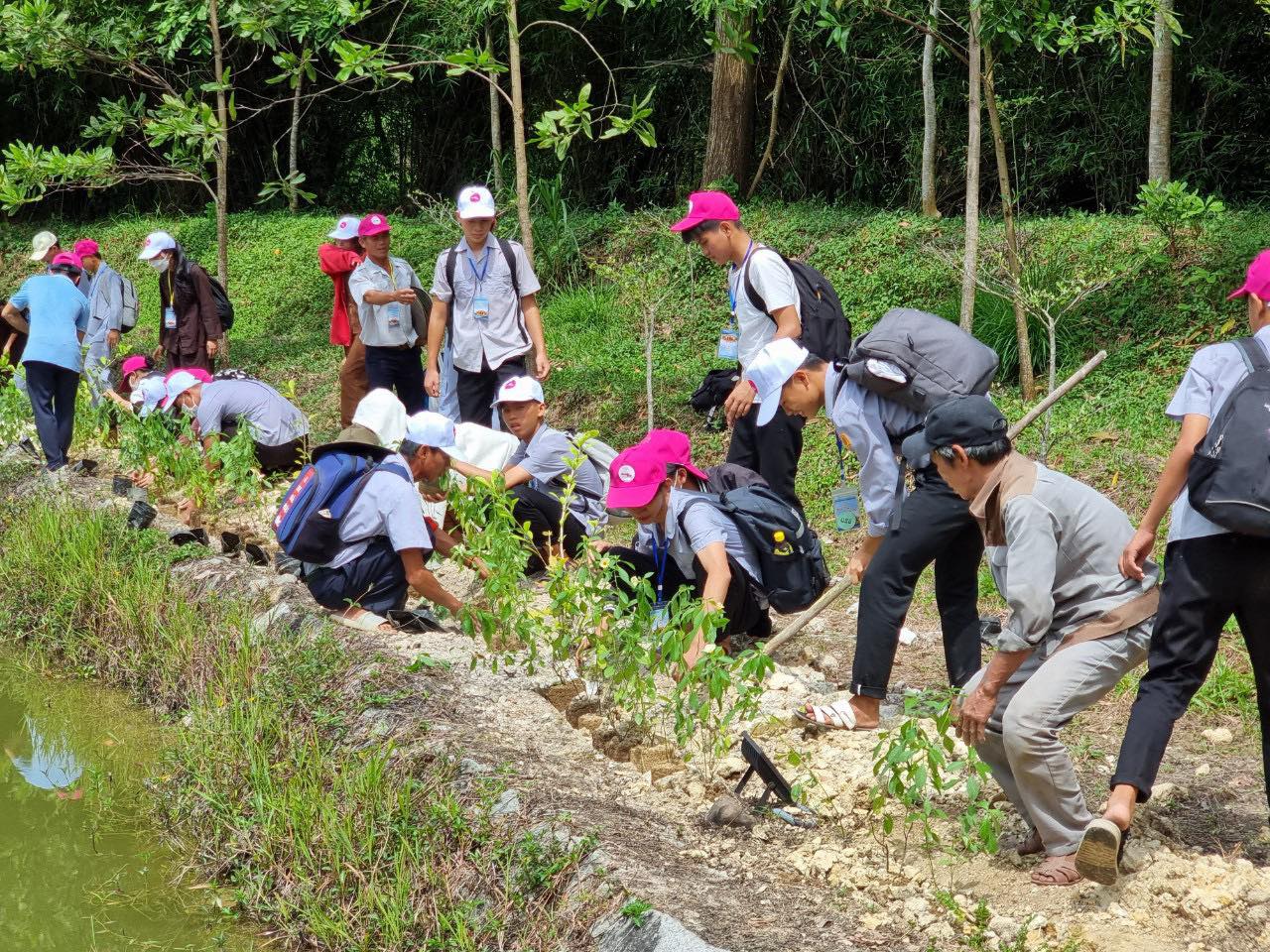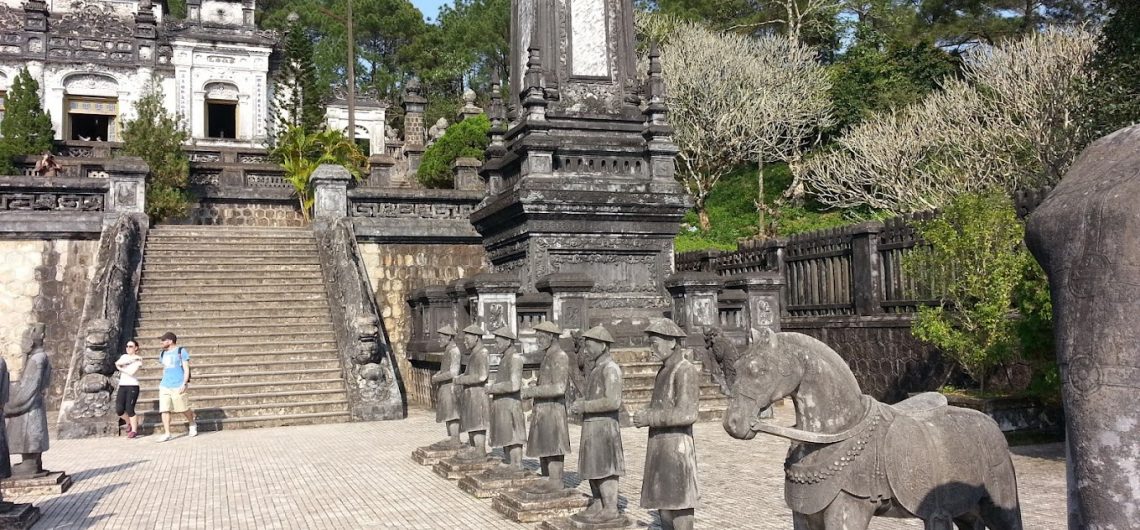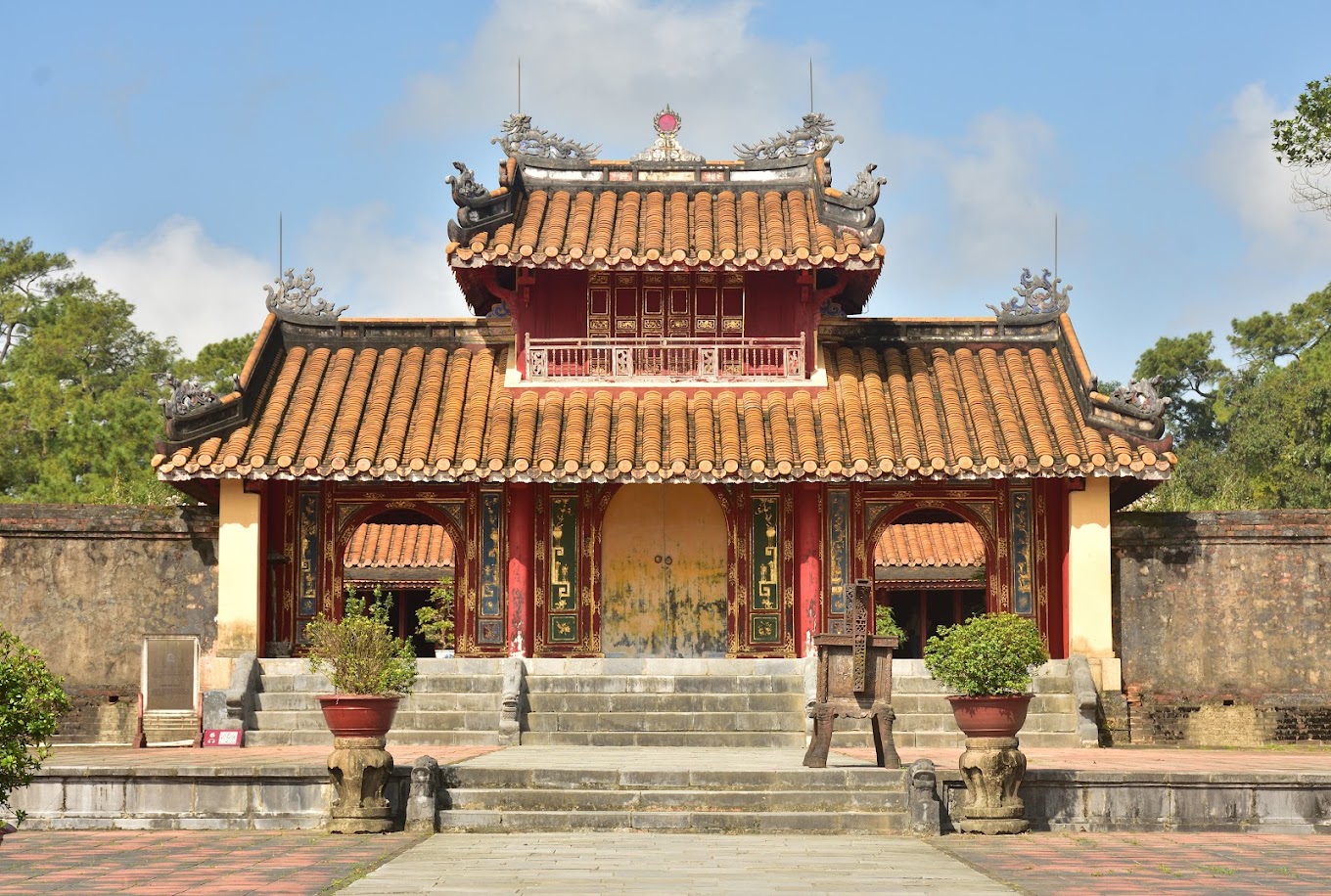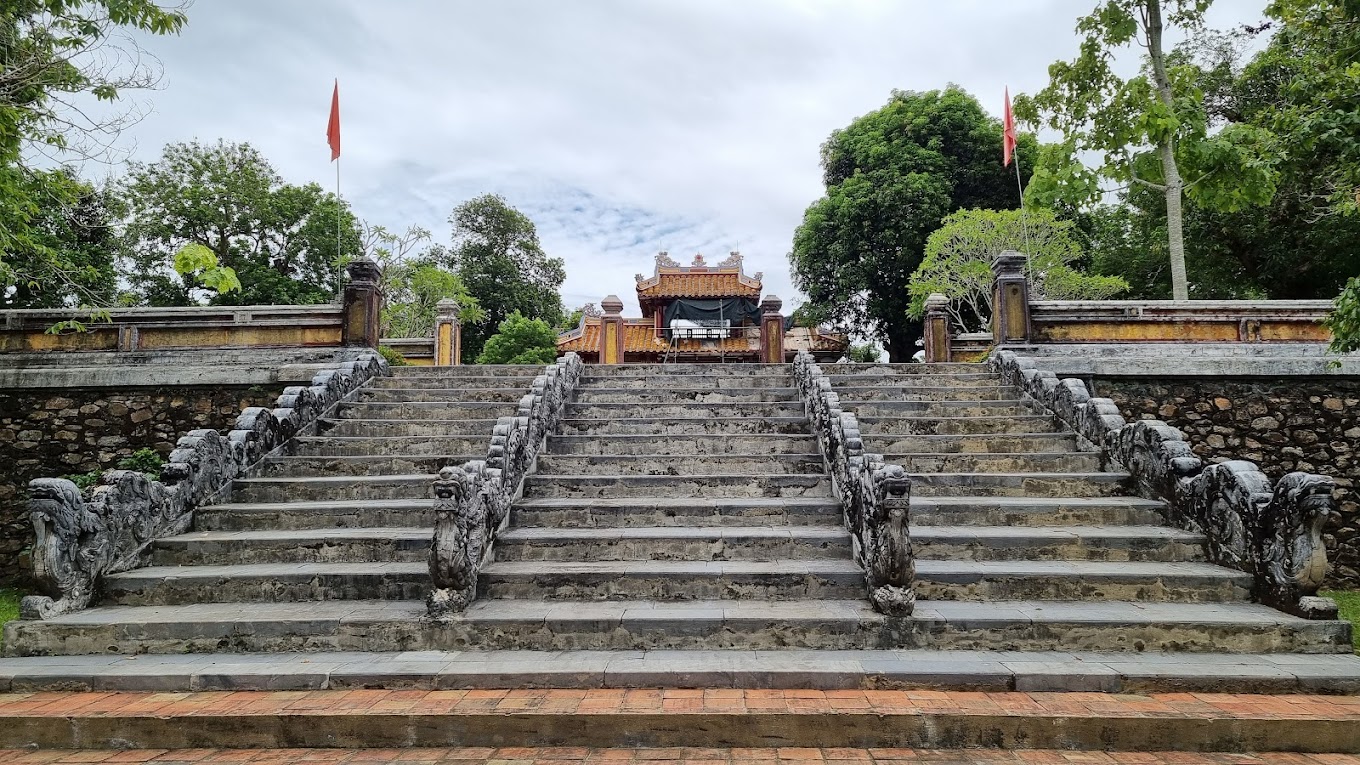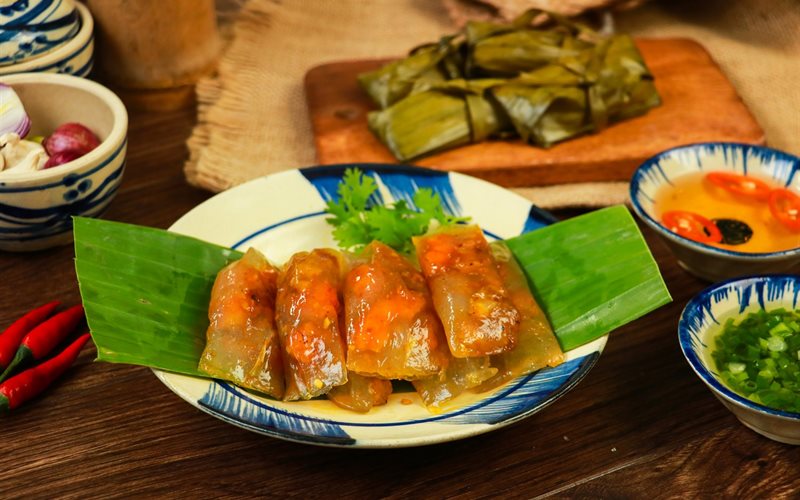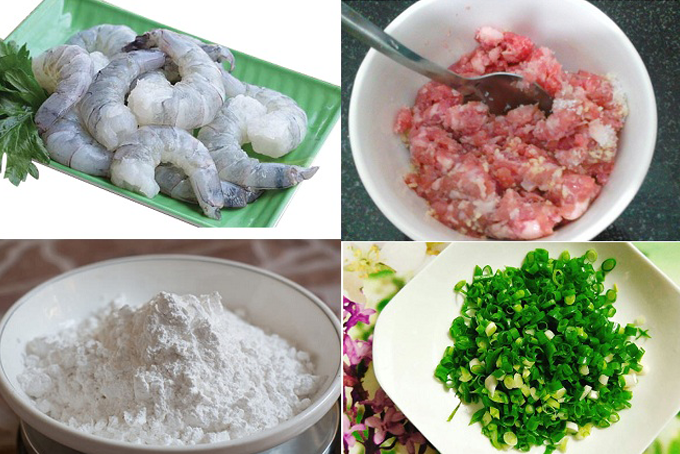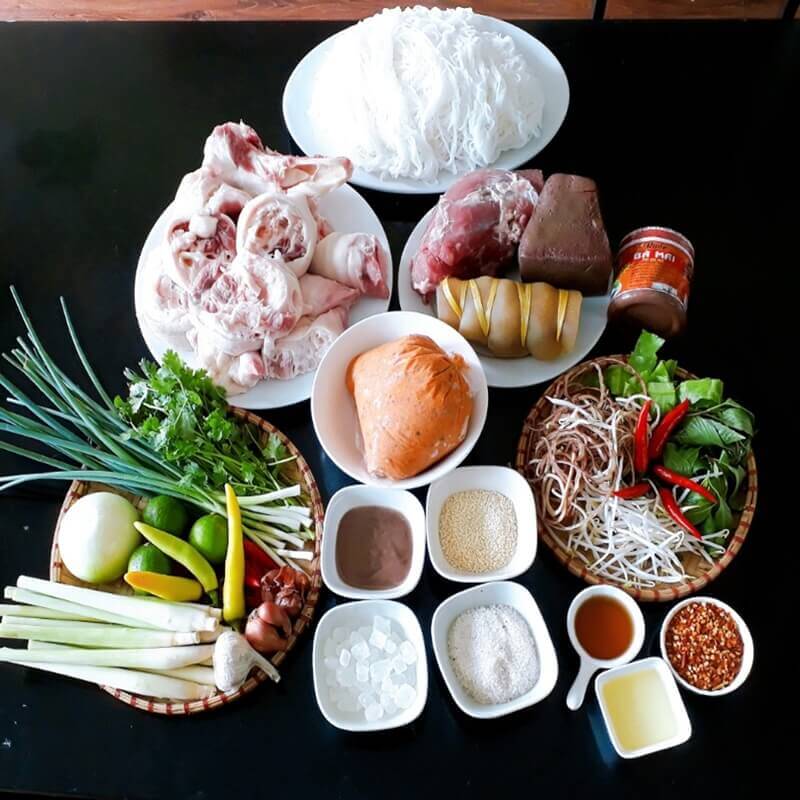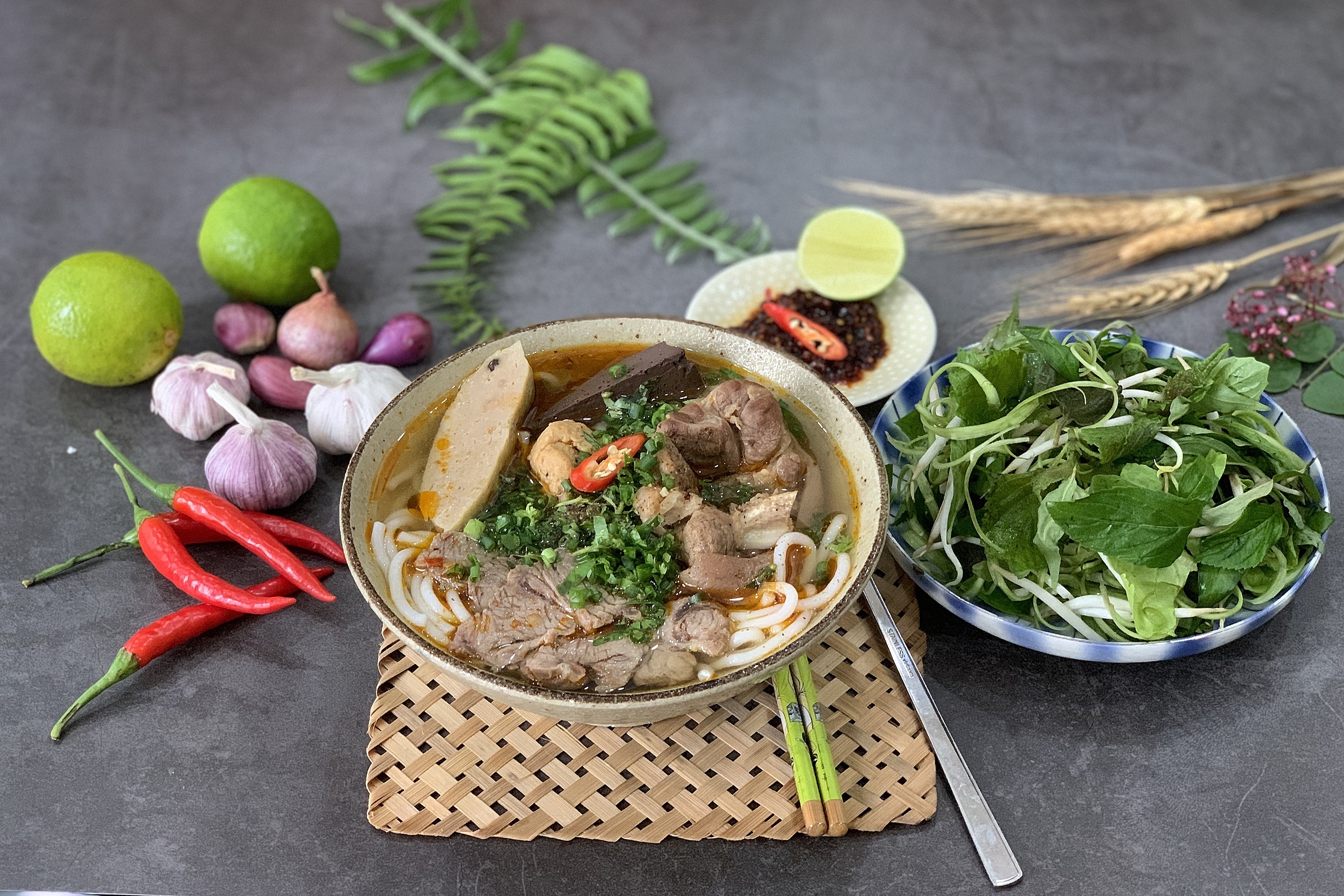The Hue Pedestrian Street brings a completely different appearance to the ancient capital. Hue is famous for its romantic and ancient architectural structures. However, there is another side of Hue that is lively and vibrant, which you can fully experience only by visiting it in person. That is the attraction of the pedestrian streets located in the heart of the imperial city, which you can explore right here with DanangPrivateCar.com’s.
Does Hue have a pedestrian street? How many pedestrian streets are there in Hue?
When mentioning Hue, tourists often think of the Hue Imperial City, the royal citadel. Tombs, pagodas, ancient houses… with their ancient architectural beauty contribute to the iconic image of the former capital. All the cultural and historical tourist attractions or eco-tourism areas make Hue appear poetic and serene.

However, the ancient capital is not only about beautiful, romantic, peaceful places. Deep within Hue, there is a lively, vibrant side that is equally modern. You will find this when visiting the pedestrian street.
If Hanoi has the Hoan Kiem Pedestrian Street and Saigon has Bui Vien Street, the former capital is no less impressive with three famous pedestrian streets.
When night falls, the pedestrian streets in the ancient capital come to life. Shops, cafes, pubs, and restaurants open their doors to welcome guests. From dusk until midnight, the pedestrian streets become bustling and lively with tourists.
The dreamlike land has three famous pedestrian streets in Hue – Hue Night Walking Street:
- Nguyen Dinh Chieu Pedestrian Street.
- Hue Western Street.
- Hai Ba Trung Pedestrian Street.
In addition to the three famous streets, Hue also has several other attractive pedestrian streets. These include Le Huan Hue Pedestrian Street, Nguyen Hue Hue Pedestrian Street. Hue also used to open Hoang Thanh Hue Pedestrian Street.
If you are looking for transportation for a solo trip, book a private car with a driver in Hue from danangprivatecar.com for the most convenient journey. With a team of professional drivers who are knowledgeable about the local culture, they will help you have the best travel experience.
Hue Pedestrian Street – One of the recreational spots for locals and tourists.
It is not by chance that pedestrian streets have gradually become the most attractive destinations in Hue. The pedestrian streets resemble a complex of entertainment, shopping, and vibrant culinary experiences as night falls.
Why does Hue implement pedestrian streets?
When mentioning the ancient capital of Hue, tourists often think of a land of old royal dynasties. It is a place of serene beauty, ancient charm, nestled beside the poetic Perfume River.
Hue tourism has always been appealing not only to domestic tourists but also to international friends. It is a famous city on the world tourism map. Therefore, Hue is constantly renewing itself.

To enhance the experience for tourists, especially with the desire to make them stay in Hue longer, there is a need for new and more attractive destinations, especially during the night. Thus, the construction and investment in nighttime entertainment and sightseeing spots are crucial.
Pedestrian streets are born with a youthful and vibrant image. As night falls, the streets light up, and crowds of people gather, making it increasingly lively and bustling.
Hue Pedestrian Street, along with Nguyen Hue Pedestrian Street, Bui Vien Street in Saigon, or Hoan Kiem Pedestrian Street, has become a captivating feature when night falls in major cities. The pedestrian streets have transformed the appearance of the ancient capital. Hue is no longer melancholic and quiet in the eyes of the younger generation.
Hue Pedestrian Street attracts many locals and tourists.
It can be affirmed that the pedestrian street is an ideal destination for walking and sightseeing. Moreover, if you are looking for a place to gather with friends, enjoy delicious food, and have late-night conversations, the pedestrian street is the perfect meeting point. It brings a new and vibrant look to the ancient capital.
The pedestrian street is a culinary and shopping “paradise.” Additionally, you can enjoy unique music and cultural “feasts” here. Or simply, you can check-in in the sparkling and romantic space of the city, situated by the poetic Perfume River. Surely, you will create countless new and unforgettable memories.

The diverse experiences attract a constant flow of visitors. Currently, when it comes to exploring the attractions in the ancient capital at night, many people immediately think of the pedestrian street.
With billions of dong invested, the street systems, lighting, drainage, trees, and telecommunications in these pedestrian streets have become complete and modern. This helps meet the needs for entertainment and leisure. Come to the pedestrian street and immerse yourself in the vibrant and lively atmosphere of Hue today!
Explore the city of Hue and its mausoleums by Hue City Tour By Private Car.
Famous pedestrian streets in Hue that you should visit and experience.
The pedestrian streets in the ancient capital of Hue have been invested billions of dong. This provides domestic and international tourists with a quality, large-scale, and professional entertainment destination. So, what pedestrian streets does Hue have? Let’s explore the details right now with DanangPrivateCar.com’s!
Hue Pedestrian Street – Western Quarter.
This pedestrian street in Hue is known as the “Western Quarter.” Previously, this location mainly served international tourists. However, the Western Quarter has gradually become a popular place for local residents and domestic tourists.
Address of Hue Pedestrian Street – Western Quarter.
The Western Quarter is located at 29 Chu Van An Street, Phu Hoi Ward, Hue City. The Western Quarter in Hue includes the three busiest streets in the ancient capital: Pham Ngu Lao Street, Chu Van An Street, and Vo Thi Sau Street. The Western Quarter spans over 1km.
Operating hours: From 6:00 PM to 2:00 AM the next morning. The opening hours are from 6:00 PM to 12:00 AM on Fridays, Saturdays, and Sundays.

Directions to the Western Quarter.
Where is Hue Pedestrian Street? The Western Quarter is located on the north bank of the Hue Imperial City. It is centrally located, extremely favorable, and easy to find. Therefore, even if you are a first-time visitor to Hue, you can easily locate the “coordinates” of the Western Quarter.
If you start from Hue Station, go straight along Le Loi Street. Travel about 2.5km, then turn right onto Chu Van An Street. You will see Hue’s Western Quarter in front of you.
On the way to the Western Quarter, you can also visit other famous attractions. Such as An Dinh Palace (about 2km from the Western Quarter). Or Dong Ba Market, which is a little over 1km from the pedestrian street.
Nguyen Dinh Chieu Pedestrian Street in Hue.
Nguyen Dinh Chieu Pedestrian Street has been emphasized in its construction and invested in various facilities and services. All of this aims to provide tourists and local residents with an ideal nighttime entertainment destination.
Address and operating hours.
This pedestrian street in Hue is the earliest pedestrian street to be established in Hue. It is the first destination that gives Hue a new and unique appearance for visitors.
Previously, only Hanoi and Saigon had pedestrian streets. And Nguyen Dinh Chieu Street, vibrant and modern, quickly became a famous destination.
Nguyen Dinh Chieu Street is conveniently located, in a highly favorable position. This tourist spot in Hue is situated right next to the picturesque Perfume River, in the inner city area.
Which street is Hue Pedestrian Street? Nguyen Dinh Chieu Street is located on Nguyen Dinh Chieu Street, Phu Hoi Ward.
Operating hours: From 4:00 PM to 10:00 PM, Monday to Saturday. On Sundays, Nguyen Dinh Chieu Street welcomes visitors from the morning.

Directions to Nguyen Dinh Chieu Pedestrian Street.
DanangPrivateCar can confirm that Nguyen Dinh Chieu Pedestrian Street is an ideal destination for everyone. From adults to young people, or children. Regardless of age, you can find something appealing for yourself when you visit Nguyen Dinh Chieu Pedestrian Street.
Also located in the heart of Hue, right in the city center. Therefore, it only takes tourists a little over 300 meters to travel from the inner city to this street.
If you start from Truong Tien Bridge, turn right onto Le Loi Street. Continue until you reach Nguyen Dinh Chieu Street. Turn right onto Nguyen Dinh Chieu Street. After driving another 30 meters, you will reach this pedestrian street in Hue.
Hai Ba Trung Pedestrian Street in Hue.
In recent times, Hue has focused on developing the Western Street, Nguyen Dinh Chieu Street – Hue Imperial City Night Street. These streets contribute to creating an attractive tourism product in Hue at night. To further transform the ancient capital into a dynamic and colorful tourist city, Hue has implemented Hai Ba Trung Pedestrian Street.
Information about Hai Ba Trung Pedestrian Street.
In March 2023, the ancient capital officially inaugurated Hai Ba Trung Pedestrian Street. Despite being “late to the party,” this street is still as “hot” as other pedestrian streets.
This is achieved by inheriting the advantages of the existing streets while investing in unique features. Hai Ba Trung Pedestrian Street in Hue combines existing commercial areas with local services, forming a bustling street for entertainment. Here, you can find restaurants, eateries, and attractive nighttime entertainment services.
Moreover, this newly opened pedestrian street in Hue also hosts street performances, music exchanges, cultural and artistic events… This is the unique and distinctive aspect of Hai Ba Trung Street compared to other streets in Hue.

Directions to the pedestrian street.
Which street is Hue Pedestrian Street on? Hai Ba Trung Street is located on Hai Ba Trung Street, Vinh Ninh Ward, Hue City. Starting from Truong Tien Bridge, turn right.
Enter Le Loi Street and continue straight until you reach Hoang Hoa Tham Street. Turn left onto Hoang Hoa Tham Street. Then, proceed until you reach Dong Da Street and turn right. Finally, turn right onto Hai Ba Trung Street.
What attractive experiences do Hue pedestrian streets offer?
Pedestrian streets are complex destinations that offer various forms of entertainment and leisure activities. It’s no coincidence that these streets play a significant role in changing the landscape of the ancient capital. Hue’s pedestrian streets make the ancient capital more modern and dynamic. Let’s follow DanangPrivateCar.com’s to explore the “complete” pedestrian streets.
Strolling, enjoying the scenery, and capturing Instagram-worthy moments.
The beauty of the Perfume River has long been the trademark of the dreamy land – Hue. When you visit Nguyen Dinh Chieu Pedestrian Street, you can fully admire this breathtaking scenery.

What could be better than leisurely strolling and feeling the breeze along the Perfume River? Or witnessing a romantic sunset by the river? You can also marvel at the enchanting beauty of Truong Tien Bridge when it lights up.
Therefore, it’s easy to understand why Nguyen Dinh Chieu Street has become an ideal “Instagrammable” spot for tourists. Additionally, on other pedestrian streets, tourists can also wander around, enjoy the scenery, and immerse themselves in the lively atmosphere filled with music, laughter, and cheer.
Relaxation and contemplation of Hue’s nightlife.
Hue’s pedestrian streets offer a different perspective of the ancient capital to visitors. Here, Hue is no longer silent and tranquil but becomes vibrant, bustling, and dazzling.
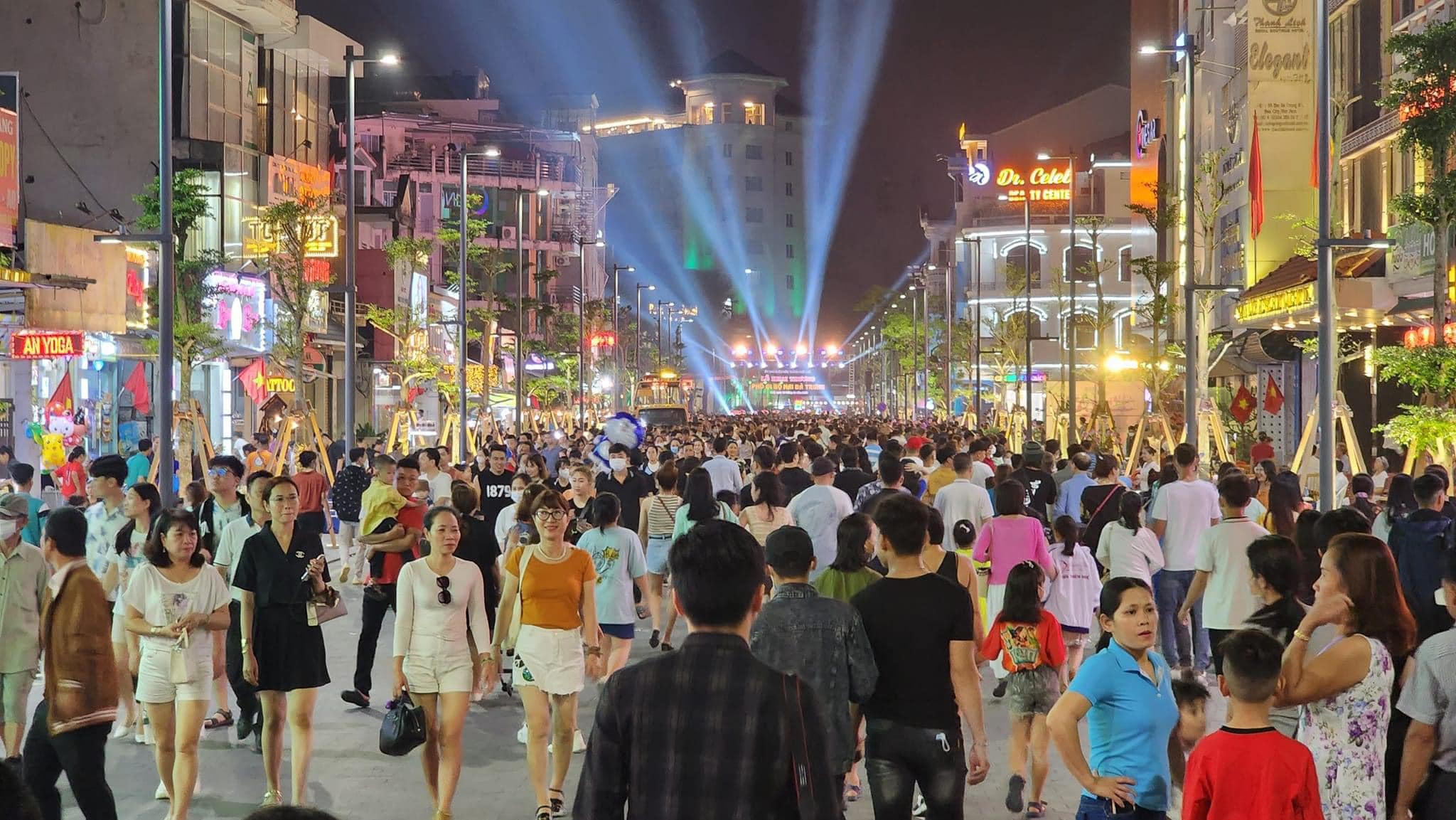
On these streets, people flow back and forth. On both sides of the road, restaurants and shops light up brightly, blending with the lively music. Walking around the various pedestrian streets in Hue, everyone can feel the vibrant and lively rhythm of life.
Enjoying irresistible local specialties and delicious street food.
After a long stroll, surely everyone feels their stomach rumbling. At this moment, the enticing aroma from the street restaurants and food stalls stimulates the taste buds.
There’s no need to hesitate, it’s time to indulge in the irresistible delicacies. On the pedestrian streets, you can find countless delicious dishes. From Hue specialties and regional delicacies to a menu of Asian and European dishes.
Nguyen Dinh Chieu Pedestrian Street and Hai Ba Trung Pedestrian Street are the places specializing in serving Hue cuisine. Additionally, there are also street snacks available. The prices of these delicious dishes on Hue’s pedestrian streets are very affordable. From rice with baby clams, baby clam vermicelli, skewered meat, beef vermicelli, savory pancakes, Hue-style rice dumplings, steamed rice cakes, and water fern cakes. Even bread, Hue-style desserts, grilled corn, and the 36 royal desserts… Everything you desire!
If you visit the Western-style area, you can also find more upscale restaurants and bars. These establishments specialize in serving food and drinks from Western and European cuisines. The prices may be a bit higher, but they promise to bring you a new and exciting style of enjoyment.
Immerse yourself in unique musical performances.
The lively and joyful atmosphere on Hue’s pedestrian streets is partly thanks to the street art performances. From cultural and artistic shows, traditional musical instrument performances, to singing, dancing, and modern dancing. All of these make it hard for tourists, especially international visitors, to take their eyes off the performances.
Check-in at super cool coffee shops with amazing views.
What does Hue’s pedestrian street offer? Besides the affordable and high-quality restaurants and food stalls, there are also many incredibly chill coffee shops. If you don’t feel like eating and simply want to find a quiet space to sit, listen to music, chat, and enjoy the scenery, you can choose a beautiful location in one of the coffee shops right on the pedestrian street. Although they are located in bustling pedestrian streets, the prices of drinks in these coffee shops are not too high. The prices usually range from 30,000 to 60,000 VND per cup.
Below is a LIST of some coffee shops that promise to be perfect stops for visiting Hue’s pedestrian street.
- Tà Vẹt Cafe: From around 6:00 PM onwards, Tà Vẹt serves light snacks. Before 6:00 PM, it is a coffee shop that “captures the hearts” of tourists in Hue. The place is famous for its quality drinks. Along with that is a uniquely designed space with a rustic and distinctive style.
- Céci Station: If you are traveling with your family, this restaurant-café is an ideal meeting place. Céci Station has a space that carries the characteristic features of Vietnamese culture. The traditional and rustic beauty is reflected in the decoration, interior design, and presentation of food and drinks.
- Gecko Cafe – Restaurant: This is a restaurant-cum-café with a European style in the Western-style area of Hue.
Drinking in the Western style in Hue’s Western-style street.
What experience makes tourists feel the most unique and special when visiting the pedestrian street? That would be drinking in the Western style in the Western-style district.

What is drinking in the Western style like? I’m sure many readers are curious, right? DanangPrivateCar.com will provide the answer right here.
When you visit Pham Ngu Lao pedestrian street, you will find many restaurants and pubs in Western style. These are establishments decorated in a luxurious, modern style with vibrant lights.
Once you enter the pub, you just need to order a few simple snacks. They can be uncomplicated dishes, such as grilled sausages, cold cuts, smoked meat, beef jerky, or roasted peanuts. Pair it with a refreshing glass of beer, a cocktail, or wine.
With just that, you can sit, chat, and enjoy the evening with your friends. Your fun can last indefinitely without worrying about getting too drunk.
In the Western-style district of Hue, tourists start to gather from around 7:00 PM. But even in the early afternoon, the restaurants and pubs here can be fully occupied. That somewhat proves the excitement of drinking in the Western style, doesn’t it?
Shopping for souvenirs.
After each trip, most tourists want to buy characteristic local products as souvenirs. And Hue’s pedestrian street is one of the ideal shopping paradises where you can find many special gifts.
The pedestrian street has dozens of stalls selling various handicrafts and specialty products from Hue. From handcrafted items like brocade bags, conical hats with poems… to exquisite and colorful traditional souvenirs.
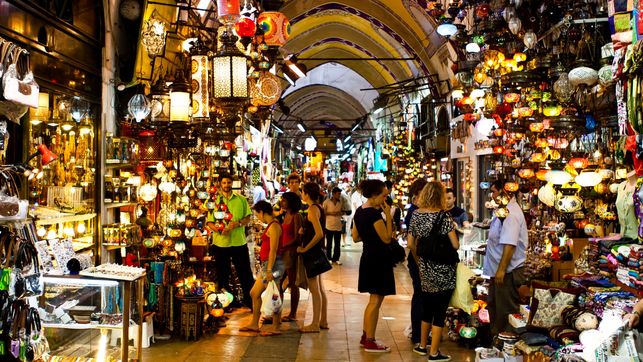
Or the imperial city’s specialties such as Hue fish sauce, pressed cakes, sesame candy, pickled shrimp… You will find a satisfying gift while shopping on the pedestrian street.
Especially, the prices of items sold on the pedestrian street are usually quite affordable. These streets are places for leisure, shopping for people of all walks of life, both locals and tourists.
Suggestions for hotels and restaurants near the pedestrian streets in Hue.
The pedestrian streets are the reason for you to stay overnight in Hue for a longer period. These streets are located in the heart of the city, so tourists have numerous choices for hotels near the pedestrian streets for their trip to Hue. Here are the TOP famous and reputable hotels that DanangPrivateCar.com’s has compiled.
Hotels near the pedestrian streets in Hue.
Moonlight Hotel Hue.
- Address: 20 Pham Ngu Lao Street, Hue City.
- Price reference: From 1,000,000 VND/night
Beaulieu Boutique Hotel.
- Address: 15 Pham Ngu Lao Street, Hue City.
- Price reference: From 650,000 VND/night
Sport 1 Hotel.
- Address: 15 Pham Ngu Lao Street, Hue City.
- Price reference: From 650,000 VND/night
Rosaleen Hotel.
- Address: 36 Chu Van An Street, Hue City.
- Price reference: From 950,000 VND/night
Orchid Hotel.
- Address: 30 Chu Van An Street, Hue City.
- Price reference: From 680,000 VND/night
Jasmine Hotel Hue.
- Address: 8-10 Chu Van An Street, Hue City.
- Price reference: From 620,000 VND/night
Hue Street Hotel.
- Address: 36 Vo Thi Sau Street, Hue City.
- Price reference: Approximately 500,000 VND/night
Restaurants in the pedestrian streets of Hue.
The restaurants in the pedestrian streets offer a wide variety of styles, ranging from traditional to modern. From restaurants specializing in Western cuisine, European dishes, or Korean and Chinese food. You can find them all in the pedestrian streets.
Rest assured, you will be amazed when you see a miniature of Hanoi’s old quarter in the dining space of the pedestrian streets. Or be surprised by a vibrant street that makes you feel like you’re in Hong Kong, Korea, or China.
What to eat in the pedestrian streets of Hue? Here is a list of restaurants in the pedestrian streets of Hue:
- Tà Vẹt Cafe: Tà Vẹt Cafe is located at the beginning of the Western street. This restaurant is always crowded with diners from the opening of the Western street until midnight.
- Xà Bần Restaurant (Xà Bần bar): Located in the center of the Western pedestrian street in Hue. The restaurant offers a diverse menu with delicious dishes. Along with that is a spacious and cozy ambiance, creating a relaxing feeling for diners.
- Lan Quế Phường: This restaurant recreates a miniature Hong Kong. It has a spacious capacity and can serve up to 500 guests at the same time. Lan Quế Phường is vibrant, colorful, and sparkling at night.
- Taboo Pub: This small bar is designed in a European style. Taboo impresses visitors with a unique car model placed on the second floor. Moreover, Taboo also stands out with a menu featuring delicious dishes and a wide selection of beers. The best-selling dish that everyone orders here is the salted egg tofu.
- Ahjussi: This is a Korean-style restaurant in the pedestrian streets of Hue. Ahjussi is an ideal gathering place for young travelers and friends.
- Vĩnh Lạc Trấn: Located at 23 Chu Van An Street. This restaurant embodies an ancient Chinese style.
- Mậu Dịch Shop: Located at 17 Vo Thi Sau Street. Mậu Dịch Shop recreates the atmosphere of Vietnam during the subsidy period. Here, diners will feel a sense of familiarity and comfort.
Visiting the pedestrian streets of Hue and some important notes to know.
After reading this, you must be eager to immediately visit all three famous pedestrian streets, right? Before heading out, let’s take a look at some important notes!
- Most of the pedestrian streets in Hue have parking lots right at the entrance. You can park your vehicle at these designated parking areas or in the underground parking of nearby hotels. However, remember to inquire about the closing time of the parking lot to ensure you can leave on time.
- The pedestrian streets usually open and operate from 5:00 PM to 6:00 PM. However, even before this time, there are already many tourists wandering around this area. Therefore, based on the travel experience in Hue, it is advisable to arrange your visit a bit earlier before the official opening time.
- As one of the hottest destinations in the ancient capital, the pedestrian streets are always bustling with people. When strolling or shopping here, remember to carefully keep an eye on your belongings. Avoid carrying too much cash or valuable items to prevent theft.
- Most of the shops and restaurants in the pedestrian streets are well-managed and have fair pricing. However, it’s still recommended to explore various types of products and bargain for the best price when shopping.
- When enjoying your time and dining in the pedestrian streets of Hue, remember to abide by the rules. Especially, do not pick flowers, break branches, or litter indiscriminately. Always have the consciousness to preserve the environment and the overall landscape.
Frequently Asked Questions about Hue Pedestrian Streets.
Above is the most detailed review of the pedestrian streets in Hue. By keeping these experiences in mind, your trip will be truly fulfilling. Finally, here are some frequently asked questions that tourists are concerned about. Let’s find the answers with DanangPrivateCar.com’s!

What time are cars prohibited on Hue pedestrian streets?
Nguyen Dinh Chieu Pedestrian Street is open from 4:00 PM to 10:00 PM, Monday to Saturday. On Sundays, it welcomes visitors all day.
Hue Western Pedestrian Street operates from 6:00 PM to 2:00 AM on Fridays and Saturdays, and from 6:00 PM to 12:00 AM every Sunday.
Hai Ba Trung Pedestrian Street welcomes visitors from 6:00 PM to 12:00 AM on Fridays, Saturdays, and Sundays.
During the opening hours, all pedestrian streets prohibit vehicular traffic to ensure absolute safety for visitors. Therefore, the car prohibition time on Hue pedestrian streets coincides with the hours of street activities.
On which days are Hue pedestrian streets open?
Nguyen Dinh Chieu Pedestrian Street and the Western Street are open every day of the week. Only Hai Ba Trung Pedestrian Street is open on weekends.
Are there places to eat and shop on the pedestrian streets?
Hue pedestrian streets offer more than just walking. Besides the romantic and bustling atmosphere for visitors to stroll and admire the scenery, there are also numerous interesting things to explore, including unique shopping and dining areas. Rest assured, you will have a colorful experience when you visit here.
It can be said that Hue pedestrian streets are an ideal destination for all tourists. It promises moments of relaxation and excellent stress relief after a busy week with work and deadlines. Make sure to add this destination to your list of must-visit tourist spots in the Ancient Capital. Hopefully, this article provides you with complete information, ready for your trip.





















